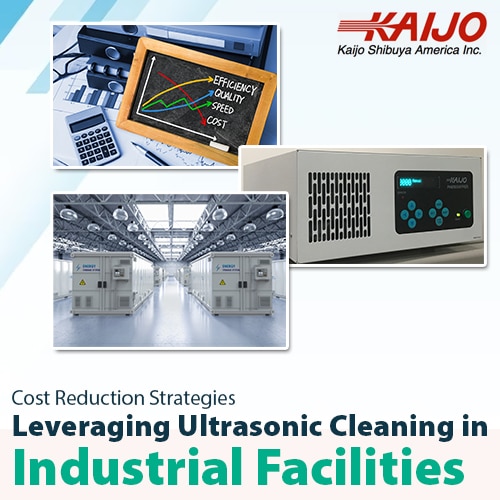Cost Reduction Strategies: Leveraging Ultrasonic Cleaning in Industrial Facilities
October 24, 2023
 Because cleaning parts and equipment is an essential component of many industrial processes, better cleaning performance can result in significant cost reductions. Ultrasonic cleaning represents a solution with lower operating costs while delivering improved cleaning. Savings can be realized in three ways:
Because cleaning parts and equipment is an essential component of many industrial processes, better cleaning performance can result in significant cost reductions. Ultrasonic cleaning represents a solution with lower operating costs while delivering improved cleaning. Savings can be realized in three ways:
- Direct savings from a reduction in the purchase of cleaning chemicals
- Indirect savings from the elimination of chemical handling and disposal costs
- Lower costs from fewer rejects and defective products due to better cleaning
Switching to ultrasonic cleaning can make an industrial operation more competitive while improving output quality.
Delving into the Details of the Ultrasonic Cleaning Process
Ultrasonic cleaning is a mechanical process that uses the scrubbing action of microscopic cavitation bubbles to dislodge contaminants from part surfaces. The cavitation bubbles form in the cleaning solution and act in tune with the ultrasonic frequency, typically between 20 kHz and the megahertz range. The action of the cavitation bubbles cleans quickly and removes foreign material completely.
An ultrasonic cleaning system comprises a high-power generator, one or more transducers, and a cleaning tank. The generator produces an electrical signal at the target frequency. Low frequencies deliver rapid and robust cleaning with comparatively large bubbles. Higher frequencies generate smaller bubbles and a gentler cleaning action. The chosen frequency should be low enough to provide adequate cleaning but high enough to avoid damaging the part surfaces.
The transducers convert the electrical, ultrasonic frequency signal into sound waves. They are immersed in the cleaning solution, and a heavy metal base vibrates in tune with the ultrasonic frequency. The sound waves fill the tank and create cavitation bubbles wherever a cleaning solution is present. While mild solvents or detergents may be added to the cleaning solution, harsh or toxic chemicals are unnecessary.
Once a facility has switched to ultrasonic cleaning, the benefits can be substantial. Threaded dead-end holes and crevices that could never be cleaned entirely before are cleaned spotlessly by the ultrasonic cleaning systems. Seams and hinges no longer require manual cleaning. The ultrasonic systems are safe and can be left unattended. Ultrasonic cleaning has been pivotal in cost reduction and quality improvement for many modern industrial facilities.
Switching to Ultrasonic Cleaning Supports Cost Reduction Strategies
Ultrasonic cleaning is generally more efficient than traditional cleaning methods. It uses less water and electricity and does not depend on chemicals. Savings in these areas vary depending on the details of the cleaning application, but they can be substantial.
Operational savings can also increase since ultrasonic cleaning works faster than traditional cleaning methods, and facility throughput increases. Ultrasonic cleaners feature less downtime and savings in manual labor. These characteristics produce cost savings in almost every aspect of operations.
Ultrasonic cleaners produce cleaner parts and equipment, less waste, and a greener manufacturing environment. Maintenance costs are reduced, machinery lifespans increase, and worker safety improves.
Ultrasonic Cleaners Can Provide Strategic Advantages
Strategic advantages provided by switching to ultrasonic cleaners can give manufacturing facilities benefits in costs, quality, and regulatory compliance. Such advantages include the following:
- Competitive Edge. Improved manufacturing techniques from ultrasonic cleaning deliver a competitive advantage in the market. Product quality is higher and more consistent.
- Regulatory Compliance. Ultrasonic cleaning has no adverse environmental effects, so compliance is easy. Ultrasonic cleaning is a sustainable cleaning operation.
- Optimization. Ultrasonic cleaning delivers reliable and consistent performance. This allows manufacturing facilities to streamline their operations and allocate resources more efficiently.
In a competitive market, some manufacturers’ adoption of ultrasonic cleaning can force the rest to follow as the strategic advantages become apparent.
Making an Informed Purchase Decision to Ensure Ultrasonics Delivers the Expected Benefits
The first step is to specify the manufacturing facility’s cleaning needs and identify the ideal ultrasonic cleaning solution. This process should be as collaborative as possible, with input from the various stakeholders. Once the requirements are defined, the details of the ultrasonic cleaning systems can be finalized. Characteristics such as frequencies, power levels, fixed or portable transducers, and whether to use existing equipment such as cleaning tanks can be explored.
When the correct ultrasonic cleaning system is selected, cost reduction and quality improvement benefits will follow. As a leader in ultrasonic cleaning technology, Kaijo offers a free consultation to potential customers to discuss how ultrasonics can be used in their applications. Kaijo helps manufacturers explore ultrasonic cleaning possibilities without obligation. Contact Kaijo to discuss how ultrasonic cleaning can improve your efficiency and quality of results while reducing costs.





